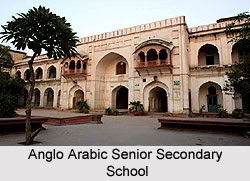 Anglo Arabic Senior Secondary School, also known as Anglo Arabic School, is located in Delhi. It is co-educational school run by the government. The college was established in 1696 by Ghazi ud-Din Khan Feroze Jung I. The school is managed by Delhi Education Society. Najeeb Jung is the President of the School Managing Committee.
Anglo Arabic Senior Secondary School, also known as Anglo Arabic School, is located in Delhi. It is co-educational school run by the government. The college was established in 1696 by Ghazi ud-Din Khan Feroze Jung I. The school is managed by Delhi Education Society. Najeeb Jung is the President of the School Managing Committee.
History of Anglo Arabic Senior Secondary School
Anglo Arabic Senior Secondary School was found by Ghaziuddin Khan. He served as the general of Mughal Emperor Aurangzeb. He was a foremost Deccan commander and the father of Qamar-ud-din Khan, Asaf Jah I, the founder of the Asaf Jahi dynasty of Hyderabad. The Madrasa closed in the early 1790s when the Mughal Dynasty was on the verge of declining. The college has gained much name and fame as the centre for education catering to literature, science and art. The Vernacular Translation Society, formed in 1832, would translate the best works in German, French and English to Urdu. After being closed for around seven years due to the Sepoy Mutiny of 1857, the institute was reopened in 1867 as Anglo Arabic College. It later became Delhi College.
Anglo Arabic Senior Secondary School was built in the surrounding area of the New Delhi Railway Station. It was located just outside the walled city of Delhi outside the Ajmeri Gate. The college was enclosed by high walls and was connected to the walled city fortifications. It was then known as College Bastion. Later the British East India Company restructured it as the `Anglo Arabic College` in 1828. It was done to redefine its objectives and to impart education in English language and literature. The main aim of the East India Company was to uplift the common masses and to educate the people of India. The institution was run by Charles Trevelyan, the brother-in-law of Thomas Babingdon Macaulay. Soon official secret Holy Bible classes were initiated by Rev. Jennings in Delhi College.
Anglo Arabic Senior Secondary School is adorned with minutely carved arches and beams. The elegant "jaali" work on the windows and the two cloisters enhances the looks and charm of the building. The school is one of the Asia`s oldest educational institutions. During the 1830s and 40s it was the centre of Delhi`s Renaissance. There is an inscription outside the gates of the building. There is also a wooden board with the names of former principals written on it. "Mr Federick Taylor- 1836 to 1840," is followed by "Mr Botrus - 1841 to 1845." They served the institution was in its peak level. According to another tablet outside chemistry laboratory Etemad-ud-Daula, Zia-ul-Mulk, Syed Fazal Ali Khan Bahadur Sahab Jung had provided 1.70 lakhs rupees for the propagation of this institution and gave it in the trust of the British East India Company in 1829. Being one of the ancient buildings of the city it narrates the chronicles of the city of Delhi.



















